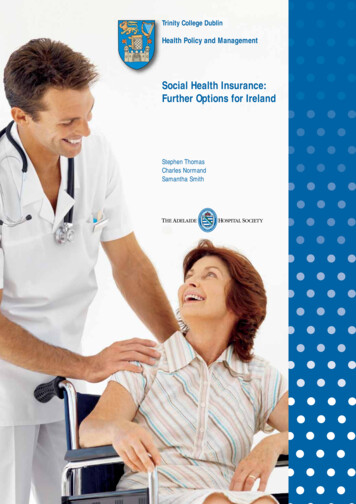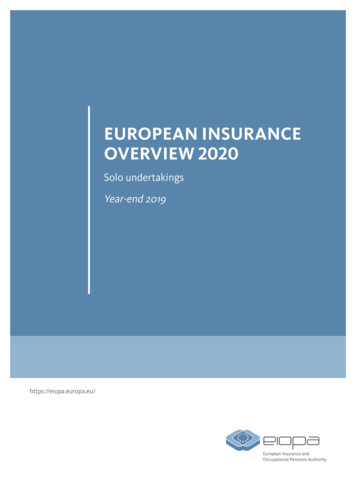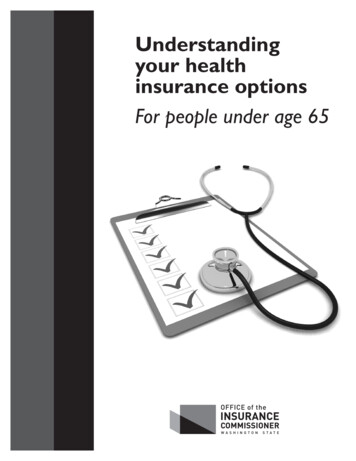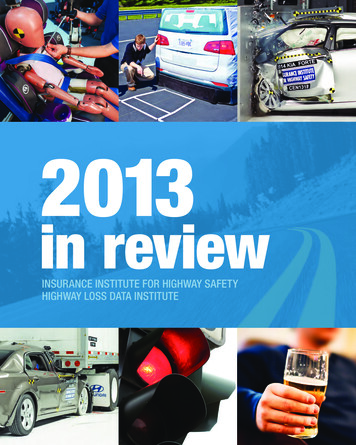
Transcription
Trinity College DublinHealth Policy and ManagementSocial Health Insurance:Further Options for IrelandStephen ThomasCharles NormandSamantha Smith
Contact:Health Policy and Management, TCD3-4 Foster Place, Dublin 2Tel: 01 – 6082201Email: hsmsec@tcd.iePublished by The Adelaide Hospital Society, April 2008
1Social Health Insurance: Further Options for IrelandPrefaceThis Report, Social Health Insurance: Further Options for Ireland, follows the landmark Report Social Health Insurance: Options for Irelandpublished by The Adelaide Hospital Society in November 2006.The financing of healthcare is the most fundamental mechanism of any healthcare system and, therefore, reform of the financialarrangements is the key lever to use in affecting how any health system performs. This is now increasingly recognised in public debateconcerning the crisis-laden Irish healthcare system. Many now advocate a comprehensive compulsory social health insurance systemcarefully designed to meet clear objectives of equal treatment for equal need and so ending the current unacceptable ‘two-tier’arrangements.The concept and practice of Social Health Insurance (often loosely referred to as “Universal Health Insurance”) is a central issue in thecurrent major debate concerning the reform of the health system in the United States of America. Leading contenders for the Presidencyare now advocating Universal Health Insurance based solutions. Of course, Social Health Insurance has underpinned the health systemsof many European Union countries providing more effective and less costly healthcare than that which obtains in the USA.A social health insurance system in Ireland could provide free GP care for all provide equal hospital treatment according to need as every citizen would be an insured patient ensure more effective and efficient healthcare providers as the ‘money would follow the patient’, therefore helping to ensure qualityof care restore transparency and public trust in providing the necessary resources for healthcareThis Report, independently prepared by authors Dr Stephen Thomas, Professor Charles Normand, Ms Samantha Smith of Trinity College,Dublin, demonstrates that the challenges in achieving such outcomes can be met and that the options are both feasible in themselvesand might be used as stages in development towards a fully developed comprehensive social health insurance funding system for Irishhealthcare. The Report updates the analysis with the most recent cost data available, models additional scenarios focusing on increasingchildren’s access to healthcare, reviews strategies to alleviate current capacity bottlenecks so that social health insurance might beimplemented, discusses options which might be phased and outlines a road map for implementation.The Adelaide Hospital Society in a number of policy papers has advocated evidence-based solutions to address the continuing crisis inhealthcare and in particular the gross inequities and unequal access experienced by so many citizens in our health system. We believein social solidarity in respect of healthcare: that each citizen contributes to the overall burden of healthcare according to their means andthat each citizen accesses healthcare according to their need. It is the European social model with the agreed overarching values ofuniversality, access to good quality care, equity and solidarity (see EU Council Conclusions on Common Values and Principles in EuropeanUnion Health Systems, June, 2006).We are, therefore, pleased to publish this Report which we hope will contribute to policy development and implementation in respect ofthe necessary reform of how we finance and provide healthcare in Ireland. This now is a national challenge which we feel, with politicalleadership and will, can be successfully met, for surely Irish citizens deserve what is commonplace in other European Union countries:access to quality healthcare when needed without financial discrimination. We are most grateful to the professional and authoritativecontribution from the authors and commend this seminal Report to all who genuinely seek to solve Ireland’s healthcare crisis.Professor Ian GrahamPresidentProfessor Tom O’DowdChair, Health Policy CommitteeDr David MooreChairmanDr Fergus O'FerrallDirectorAdelaide & Meath Hospital, Tallaght, Dublin 24Tel: (01) 414 2071/414 2072 Fax: (01) 414 2070Email: info@adelaide.ie Web: www.adelaide.ie
2Social Health Insurance: Further Options for IrelandExecutive Summary1.Full medical cards to all children (under 19) would cost only 160million; this represents an increase of just over 2% in real termson healthcare funding.2.A version of social health insurance that involves upgrading the access to healthcare services for the worse-off segments of thepopulation to that of the best-off would increase the total health expenditure as a proportion of GDP from 7.5% to 8.9% for 2006prices.a.This represents an increase of about 2.1billion in running costs but such a proportion of GDP is low for a comprehensiveSHI system.b.This Rolls Royce option would include guaranteed and timely access to hospital consultants, free primary healthcareconsultations, free primary healthcare prescriptions and some limited support for long-term care3.Full medical cards for all the population would cost just over 3 billion per year. However, government is already paying just under 2.1 billion on PHC and households a further 692 million. This leaves a funding gap of only 217 million.4.Whether or not Ireland introduces comprehensive health insurance there is required a very significant financial investment to meetcurrent and future capacity constraints in the period up to 2020. The additional costs associated with capacity improvement forsocial health insurance account for only 25% of this overall investment5.A key capacity constraint for Ireland to improve health care provision is the scarcity of skilled health professionals. In particular:a. Ireland has relatively few primary care providers in comparison to other EU15 countries at 52 GPs per 100,000 population(France has 164, Austria 144, Germany 102 per 100,000 population). If no action is taken to enhance GP supply Ireland cannotmaintain even the current low GP : population ratio because of the retirement of existing GPs and an increased population. Withno action there is likely to be a shortfall of 230 GPs by 2010 increasing to 400 by 2020. To implement free access to GPswith social health insurance there would be a gap of 814 GPs by 2020. The cost implications of fully funding increased trainingare approximately 60 million per year for the next 12 years.b. Ireland has a very low number of consultants per 1000 population with 2,100 consultants (2006) and there is a need to bringthis figure to 3,100 consultants in line with the Hanly report.6.International comparisons within OECD countries show that Ireland has a very low number of acute beds per head of population(2.9 per 1000 in 2004). Comparative analysis does not suggest that inefficiency is a core problem in the acute hospital sector.Therefore, unless huge changes are made in the provision of community services, not least involving increasing GP supply (point5a) and associated facilities, then acute bed capacity will have to increase substantially. The study suggests, in line with othersimilar research, there is a need for approximately 2500 beds (without social health insurance) and between 3000 and 4100 (withsocial health insurance) to cover the period to 2020.7.Moving to an SHI system would require a reorganisation of services, toward a contracting model with a central fund or fundspurchasing care from more autonomous providers with strengthened local management.
Social Health Insurance: Further Options for IrelandTable of ContentsIntroduction . . . . . . . . . . . . . . . . . . . . . . . . . . . . . . . . . . . . . . . . . . . . . . . . . . . . . . . . . . . . . . . . . . . . . . . . . . . . . . . . . . . . . . . . 51. Updating the Cost Estimates . . . . . . . . . . . . . . . . . . . . . . . . . . . . . . . . . . . . . . . . . . . . . . . . . . . . . . . . . . . . . . . . . . . . . . . . . . . 5Methods . . . . . . . . . . . . . . . . . . . . . . . . . . . . . . . . . . . . . . . . . . . . . . . . . . . . . . . . . . . . . . . . . . . . . . . . . . . . . . . . . . . . . . . . . . . 5Results . . . . . . . . . . . . . . . . . . . . . . . . . . . . . . . . . . . . . . . . . . . . . . . . . . . . . . . . . . . . . . . . . . . . . . . . . . . . . . . . . . . . . . . . . . . . 72. New Scenarios. . . . . . . . . . . . . . . . . . . . . . . . . . . . . . . . . . . . . . . . . . . . . . . . . . . . . . . . . . . . . . . . . . . . . . . . . . . . . . . . . . . . 92. 1. Improving Access to GP services for children. . . . . . . . . . . . . . . . . . . . . . . . . . . . . . . . . . . . . . . . . . . . . . . . . . . . . . . . . . . . . 92. 2. Full insurance coverage for the under 16s . . . . . . . . . . . . . . . . . . . . . . . . . . . . . . . . . . . . . . . . . . . . . . . . . . . . . . . . . . . . . . 103. Increasing Capacity . . . . . . . . . . . . . . . . . . . . . . . . . . . . . . . . . . . . . . . . . . . . . . . . . . . . . . . . . . . . . . . . . . . . . . . . . . . . . . 113.1 Introduction . . . . . . . . . . . . . . . . . . . . . . . . . . . . . . . . . . . . . . . . . . . . . . . . . . . . . . . . . . . . . . . . . . . . . . . . . . . . . . . . . . . . . 113.2 Approach . . . . . . . . . . . . . . . . . . . . . . . . . . . . . . . . . . . . . . . . . . . . . . . . . . . . . . . . . . . . . . . . . . . . . . . . . . . . . . . . . . . . . . . 113.3 Primary Health Care . . . . . . . . . . . . . . . . . . . . . . . . . . . . . . . . . . . . . . . . . . . . . . . . . . . . . . . . . . . . . . . . . . . . . . . . . . . . . . . 12Training . . . . . . . . . . . . . . . . . . . . . . . . . . . . . . . . . . . . . . . . . . . . . . . . . . . . . . . . . . . . . . . . . . . . . . . . . . . . . . . . . . . . . . . . . . . 17Overseas Recruitment. . . . . . . . . . . . . . . . . . . . . . . . . . . . . . . . . . . . . . . . . . . . . . . . . . . . . . . . . . . . . . . . . . . . . . . . . . . . . . . . . 19Incentive Packages. . . . . . . . . . . . . . . . . . . . . . . . . . . . . . . . . . . . . . . . . . . . . . . . . . . . . . . . . . . . . . . . . . . . . . . . . . . . . . . . . . . 19Facilities . . . . . . . . . . . . . . . . . . . . . . . . . . . . . . . . . . . . . . . . . . . . . . . . . . . . . . . . . . . . . . . . . . . . . . . . . . . . . . . . . . . . . . . . . . 193.4 Hospitals . . . . . . . . . . . . . . . . . . . . . . . . . . . . . . . . . . . . . . . . . . . . . . . . . . . . . . . . . . . . . . . . . . . . . . . . . . . . . . . . . . . . . . . 20Facilities . . . . . . . . . . . . . . . . . . . . . . . . . . . . . . . . . . . . . . . . . . . . . . . . . . . . . . . . . . . . . . . . . . . . . . . . . . . . . . . . . . . . . . . . . . 20Hospital Health Professionals . . . . . . . . . . . . . . . . . . . . . . . . . . . . . . . . . . . . . . . . . . . . . . . . . . . . . . . . . . . . . . . . . . . . . . . . . . . 27Summary of Costs . . . . . . . . . . . . . . . . . . . . . . . . . . . . . . . . . . . . . . . . . . . . . . . . . . . . . . . . . . . . . . . . . . . . . . . . . . . . . . . . . . . 283.5 Capacity as Health System Strengthening . . . . . . . . . . . . . . . . . . . . . . . . . . . . . . . . . . . . . . . . . . . . . . . . . . . . . . . . . . . . . . . 284. A Road Map for Policy Implementation . . . . . . . . . . . . . . . . . . . . . . . . . . . . . . . . . . . . . . . . . . . . . . . . . . . . . . . . . . . . . . . 315. Conclusions . . . . . . . . . . . . . . . . . . . . . . . . . . . . . . . . . . . . . . . . . . . . . . . . . . . . . . . . . . . . . . . . . . . . . . . . . . . . . . . . . . . . . 32References: . . . . . . . . . . . . . . . . . . . . . . . . . . . . . . . . . . . . . . . . . . . . . . . . . . . . . . . . . . . . . . . . . . . . . . . . . . . . . . . . . . . . . . . . 35Annex 1: Achieving the SHI options – Costs, Data Sources and Methods (2005 prices) . . . . . . . . . . . . . . . . . . . . . . . . . . . . . . . . . 37Annex 2: Costs of Existing Services - Data Sources . . . . . . . . . . . . . . . . . . . . . . . . . . . . . . . . . . . . . . . . . . . . . . . . . . . . . . . . . . . 40Annex 3: Selected Health Policy Commitments. . . . . . . . . . . . . . . . . . . . . . . . . . . . . . . . . . . . . . . . . . . . . . . . . . . . . . . . . . . . . . . 41Fianna Fail . . . . . . . . . . . . . . . . . . . . . . . . . . . . . . . . . . . . . . . . . . . . . . . . . . . . . . . . . . . . . . . . . . . . . . . . . . . . . . . . . . . . . . . . . 41Progressive Democrats . . . . . . . . . . . . . . . . . . . . . . . . . . . . . . . . . . . . . . . . . . . . . . . . . . . . . . . . . . . . . . . . . . . . . . . . . . . . . . . . 41Fine Gael and Labour . . . . . . . . . . . . . . . . . . . . . . . . . . . . . . . . . . . . . . . . . . . . . . . . . . . . . . . . . . . . . . . . . . . . . . . . . . . . . . . . . 41The Green Party . . . . . . . . . . . . . . . . . . . . . . . . . . . . . . . . . . . . . . . . . . . . . . . . . . . . . . . . . . . . . . . . . . . . . . . . . . . . . . . . . . . . . 42Sinn Féin . . . . . . . . . . . . . . . . . . . . . . . . . . . . . . . . . . . . . . . . . . . . . . . . . . . . . . . . . . . . . . . . . . . . . . . . . . . . . . . . . . . . . . . . . . 42Annex 4: Pabon Lasso Analysis of Hospital Efficiency . . . . . . . . . . . . . . . . . . . . . . . . . . . . . . . . . . . . . . . . . . . . . . . . . . . . . . . . . . 433
4Social Health Insurance: Further Options for Ireland
Social Health Insurance: Further Options for IrelandIntroductionThe report: ”Social Health Insurance: Options for Ireland” November 2006, (Thomas et al. 2006) focussed on evaluating the equity issuesin the Irish health system and exploring how Social Health Insurance could be applied in the Irish context to further equity objectives.Given the interest in the subject matter that the Report generated the Adelaide Hospital Society has commissioned Health Policy andManagement, Trinity College Dublin to conduct this follow-on Report.The scope of the Report is to: update previous analysis with more recent cost data; model additional scenarios, focussing on increasing children’s access to health care; review strategies to alleviate current capacity bottlenecks, to allow for the implementation of SHI; consider options for implementation and a phased extension of insurance coverage.A key aim of the report is to model the viability and desirability of various forms of SHI in the current Irish context. This involves examiningthe additional resource requirements for each model compared to currently available resources in the system. Consequently, new datahave been included in the costing of the SHI options to reflect the funds already being paid directly by households to Primary Health Careproviders. This embraces household “out-of-pocket” expenditure on GP fees and prescribed drugs which was not estimated in Thomaset al. (2006). Our approach also involves reviewing how each model contributes to the improvement of equity and this involvesunderstanding access to services for, and the distribution of the financing burden across, different segments of the population. The resultswill provide timely information for policy makers on the costs and benefits of reforming health financing to improve equity.Before proceeding, it is worth clarifying that Social Health Insurance is a mechanism to achieve a policy and not a policy in itself. Thusthe design of a SHI scheme is, or should be, dependent on the objectives to be achieved in the health system, such as value for moneyor fairness. The term “social” is therefore used to differentiate it from “private” insurance. The primary focus of private insurance is tomake a profit by reducing the risk to individuals of facing high health costs. The primary focus of SHI is pursuing what is good for societyby delinking access to serv
This Report, Social Health Insurance: Further Options for Ireland, follows the landmark Report Social Health Insurance: Options for Ireland published by The Adelaide Hospital Society in November 2006. The financing of healthcare is the most fundamental mechanism of any healthcare system and, therefore, reform of the financial










